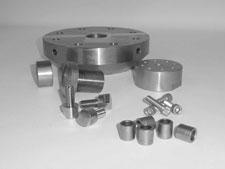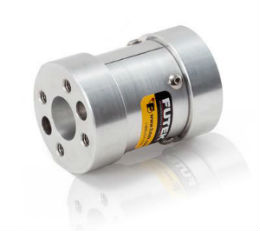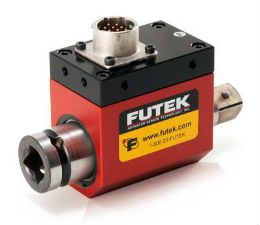Reaction and Rotary Torque Sensors
A torque sensor or sometimes called a torque converter is a measurement device to measure the torque of a machine. There are several varieties to these sensors that measure in slightly different ways. These sensors are used to help measure the performance and efficiency of the device or engine being tested. This is important for quality testing for new products or current performance diagnostics. Trouble shooting an issue is also another common reason a machine may be tested on with a torque sensor. Some use strain gauges to help measure torque while others use different means to do so. Two common types of torque sensors are reaction and rotational.

Photo Courtesy of Strainsert Company
Reaction torque sensors are typically used for torsion testing on machines that are limited to 360 degrees or less. These strict structures have no moving parts and are usually mounted in a permanent position. Because reaction torque sensors can be mounted and do not use bearings, slip rings or other rotating equipment they are cost effective. An easy way to image reaction torque is to picture a tight bottle with a screw top cap. The torque sensor would measure the torque experienced as the cap is twisted until loosened. Some reaction torque sensors also use strain gauges in their measuring. Examples where this type of senor can be found are in brake testing, viscosity and lubrication studies, bearing friction studies and more.

Photo Courtesy of Futek Advanced Sensor Technology
Another torque sensor that is commonly used is called a rotary torque sensor. These sensors commonly use strain gauges to help determine the torque being measured. These variations also have a freely rotating shaft that spins within a fixed housing to measure the torque and resistance being produced by the object(s) being measured. When the sensor is mounted and installed the shaft is placed in between the driving mechanism and a load, being the coupling connecting them. As the machine moves the stress created is able to be measured. Rotary torque sensors can be found applied to automotive engine testing, drive train measurements, dynamometer testing, electric motor testing and gearbox testing.

Photo Courtesy of Futek Advanced Sensor Technology
Although these instruments are not very large they are capable of testing immense amounts of torque. The torque measured can range anywhere between 5 in-lb to upwards of 500k in-lb. In addition, the sensors can be manufactured in aluminum or steel. Only the lower weight options are typically made of aluminum being able to withstand only the lighter forces. Knowing the difference between a reaction torque senor and rotary torque sensor are important to understand when deciding to purchase a torque sensor for a specific job. Each measures the torque of the machine or device, but only one has moving parts. These instruments can be very helpful to tell the status of the tested object and possibly diagnose issues that can be repaired putting your machine back on the path to full power!
Where have you used a torque sensor? Also, if you have used a torque sensor that is not reaction or rotary please share what it was and what it was used for. Lastly, share any advice you have into the pros and cons of these instruments.


 Castings & Forgings
Castings & Forgings Bulk Material Handling
Bulk Material Handling Electrical & Electronic Components
Electrical & Electronic Components Flow Instrumentation
Flow Instrumentation Hardware
Hardware Material Handling Equipment
Material Handling Equipment Metal Cutting Services
Metal Cutting Services Metal Forming Services
Metal Forming Services Metal Suppliers
Metal Suppliers Motion Control Products
Motion Control Products Plant & Facility Equipment
Plant & Facility Equipment Plant & Facility Supplies
Plant & Facility Supplies Plastic Molding Processes
Plastic Molding Processes Pumps & Valves
Pumps & Valves Recycling Equipment
Recycling Equipment Rubber Products & Services
Rubber Products & Services